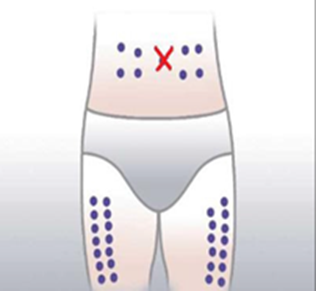Instruction for injection growth factors
De afdeling Hemaferese
The method:
Take out the require syringes from the refrigerator half an hour before administration or warm them up in your hand.
- Wash your hands. Prepare the syringe and any plaster ready on a clean surface.
- Check the syringe for damage and expiration date.
- Do not remove the air bubble present in the syringe; this ensures that all the fluid is injected, after complete injection, this air bubble will fill the space in the needle, so that all the active substance is administered. The air present in the syringe cannot cause any damage.
- The drawing shows the recommended places to give the injection (image 1)
Choose an injection site:
- In the abdomen, 3 fingers next to the navel (preferred spot)
- The top of the thighs
- Change the injection site with each injection
- If desired, do not injection a bruise, wound, stretch mark or other irregularity.

Image 1
- Take the syringe in your dominant hand and remove the protective cover from the needle, do not touch the needle or lay down the syringe.
- With the other hand, pinch a skin fold at the puncture site between your thumb and index finger (image.2). the skin must be clean, but does not have to be disinfected.
- Insert the needle into the skin fold in one motion, holding the syringe upright, the needle must be inserted all the way into the skin (image 3)
- Gently empty the syringe including the air bubble (image 4 ) when you hear a click, the syringe is completely empty.
- When “the click “is heard, the needle will automatically slide out of the skin fold and a protective cover, is placed over the needle.
- A drop of blood may appear (a capillary vessel has been hit). If necessary, wipe this away with a tissue.
- place the empty syringes (in an empty container) and take these with you to the hospital so they can be removed saftely.

Please not: Do not rub the insertion site after injection, as this may cause bruising or red discs
General information:
- Store the syringes in the refrigerator.
- If in doubt, always contact us.
- If you got a fever or pain in the left side(spleen), always contact the apheresis department.
- In case of bone pain use 8x500mg paracetamol in 24 hours, you may take 1000mg (2 tablets)at the time.
- Administer the injections according to the schedule provided at 9:00AM and 9:00PM. It is possible that the dosage of the injection varies per morning or evening dose.
- Keep used injections in a container and take them with you to the Apheresis department on the day of stem cell collection.
- About two days before you starting with the growth factors, you will be called and then you will receive an email from the apheresis nurse, with the mobilization schedule and latest information for the stem cell donation.
- On day ( day of the collection), you inject yourself in the morning before you leave for the hospital, even if this is a different time than the previous days.
- We expect you on the day of stem cell collection between 8.30 and 9:00 am at the Apheresis department C-11-P room 44 or route 265.
What are the risks, side effects or complications ?
During the days that the growth factor is administered, most donors experience are some bone, muscle and headache pain and sometimes a flu like feeling, occasionally with elevated temperature. A temperature of up to 38.5 °C is acceptable. You can use paracetamol ® against these complaints, other painkillers only in consultation with the Matchis doctor or the blood transfusion medicine doctor or the Apheresis department most of the complaints largely disappear within 24 hours after administration of the last growth factors. After 48 hours all complaints have disappeared. Very rarely, more serious side effects occur, always contact your doctor! If you have any complaints or doubts/concerns, you can call the Apheresis department. If necessary, you will be connected to the blood transfusion medicine doctor on duty.
Contact us if you have any problems after your examination/treatment?
You must contact the Apheresis department if the temperature rises above 38.5 °C, local complaints consistent with infection/inflammation or pain in the left side